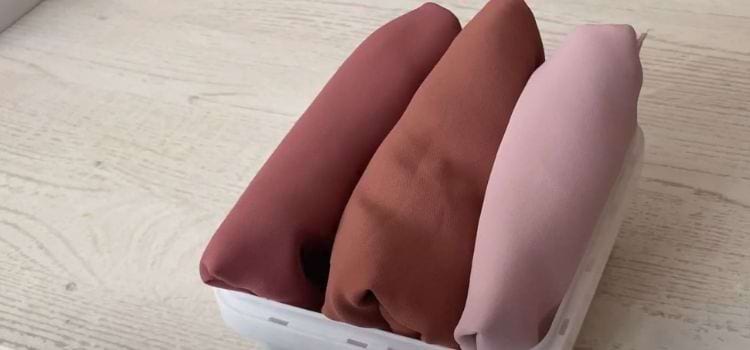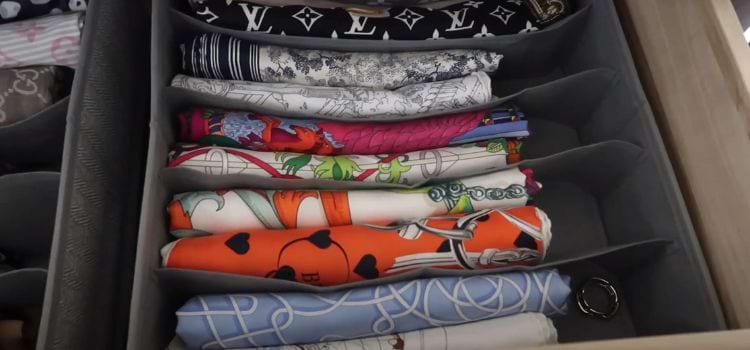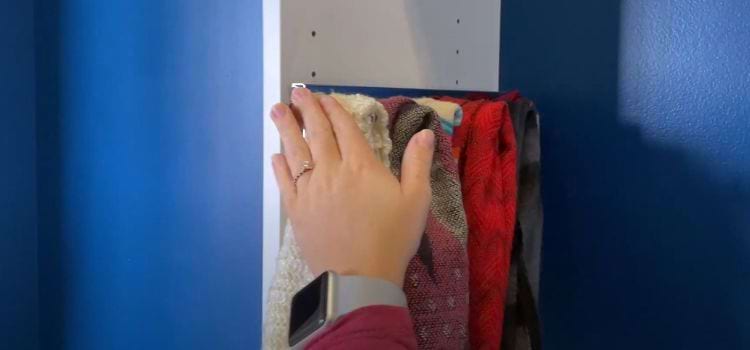As an Amazon Associate, I earn from qualifying purchases.
We all know scarves are an easy way to transform an outfit, and once other outfits get a makeover it’s going to look like a hot mess, but how exactly do we go about storing them? Not only will it keep them looking beautiful but it will also extend their lives. So how do we avoid ruining scarves and keep them wrinkle-free post-purchase? Let’s find out how to store scarves without wrinkling.

Understanding Scarf Fabrics
Scarves can be knitted, woven, or made from other textiles. Different materials are used for scarves, each implying specific ways for storage. In general, scarves are available in silk, wool, cotton, polyester, etc. You can easily roll up breathable silk scarves. Special storage is required for them because they are soft and can easily be damaged.
People can protect themselves from cold with wool scarves, but they need to be kept away from moths for storage. Cotton scarves can be easily creased and are tough, but they can withstand common uses and washes. People are expected to fold their cotton scarves into a smaller shape before storing them after the winter season. You can easily store polyester scarves and tops without them creasing and wrinkling, yet proper storage is still important for their benefit.
Pre-Storage Preparation
Before putting away your scarves, make sure that they are cleaned. Dirt and oils over time, will weaken fabrics. Machines can wash scarves that are machine-washable. Silks that are delicate will require dry-cleaning. And then iron or steam the scarves to eliminate wrinkles. You should also dry the scarves well before storing them to prevent mold and mildew.
Folding Techniques
Closing is probably the most common technique to fold a scarf. In standard, monochrome folding, you lay your scarf flat on the table, fold it halfway down its length, and fold it in half again to stuff it in your closet. Even if your scarf’s material is very thin, you can sandwich some tissue paper between the folds to keep the folds flat and increased.Marie Kondo’s KonMari system allows users to fold scarves and similar products into single-dimension, compressed rolls, making it easier for the users to store them and reducing the risk of creasing.

Rolling Method
If your scarves are on the thicker side, it is ideal to avoid wrinkles, so start by laying your scarf flat on a surface and fold it in half lengthwise, and tightly roll it from one end to another securing it with a soft hair tie or ribbon a good practice for all of your wool and cotton scarves that are too thick to just lay flat. Another way to store your wool, linen, jacquard, or cashmere scarf is by using a hanger.
Of course, avoid using a hanger that has those plastic hooks, they will just hurt the fiber and loosen the stitches of your scarf. Take your hanger that is slim at the top and wider as it keeps getting further down, fold your scarf in half, and hang it on the hook making sure the longer end of the scarf hangs to the bottom, allowing the folded part to be right over the hook. This provides a nice way to display the fabric and elegantly hang your scarf.
Hanging Scarves : Store Scarves Without Wrinkling
Hanging makes for great scarve storage if you don’t have a lot of room in your closet. To keep your scarves from forming indentations, seek out multi-loop scarf hangers and use padded hangers for each scarf. Heavy material scarves must not be hung; they should support their own weight to avoid damage. Scarves, lightweight ones like silk and polyester, won’t break when hung.
Storing Scarves in Drawers
This storage method works well with scarves in drawers since it keeps them both reachable and viewable. Use drawer dividers or organizers to separate each scarf so they will not tangle, and either fold or roll the store scarves without wrinkling before placing it in its respective space. This method works well with all scarf fabrics and conditions them.

Using Scarf Organizers
Tarantula-themed scarf organizer attached to the back of a door there are also specific scarf organizers: hanging racks or boxes with compartments that you can place under your bed or in a wardrobe will make sure your scarves remain crease-free and well organized. Choose breathable materials for boxes so scarves can avoid moisture and pests.
Store Scarves Without Wrinkling In Boxes
Storage boxes are also a good choice. Acid-free boxes will prevent your fabrics from discoloring. Line the box with tissue paper and place the folded or rolled scarves inside. Don’t overpack the box to prevent your scarves from developing pressure wrinkles. Label the boxes, especially if you’re storing them out of sight.
Vacuum-Sealed Storage
Vacuum sealing requires less space for storing the scarves and keeps them safe from dust and pests. Silk scarves, however, are delicate and, if pressed too much, they can develop permanent creases and crumples. Use vacuum-sealed bags only on scarves that tolerate compression well. Always make sure that your scarves are completely dry and free of dirt.
Traveling with Scarves
Packing scarves is somewhat tricky because careless handling will cause wrinkles. One way to accomplish this is to roll up each one and place them in a separate compartment or a specific scarf organizer. Put the scarves in a garment bag for added protection. Upon arrival, hang the store scarves without wrinkling in the bathroom while you shower the parched skin. From your day’s travels let the steam relax the wrinkles.
Storing Seasonal Scarves
Switch your scarves for the season. Put out-of-season scarves away in a cool dry place and follow the guidelines above. To ensure the highest care for long-term storage, you should keep wool scarves with mothballs or cedar chips. All scarves should be in containers that are not airtight so moisture does not build up.

DIY Scarf Storage Solutions
Get creative with DIY solutions: hang scarves on a towel rack or a ladder. Repurpose an old wine rack to organize scarves; use shower curtain rings on an everyday hanger for individual storage. These money-saving storage solutions are easy to pull off.
Maintaining Scarves in Storage
Maintenance checks are crucial. Take your scarves out of storage a few months after the season you used them. Give them a good airing and gently refold or refuel them. That way they won’t form permanent creases, and the scent will keep store scarves without wrinkling for another year. Check them for any holes or signs of pests or moisture, and attack any problems before they get serious.
Conclusion
Good scarf storage will help keep your accessories looking fresh and ready to wear. If you consider your scarves’ needs and then store them using techniques like folding, rolling, and organizers, you can avoid wrinkles and prolong their lives. Follow these best practices so you can enjoy your scarves, wrinkle-free, for years to come.
If you are going to use a fabric shopping bag, do not seal it so tightly that it traps. The moist air around your towels could lead to mildew. Instead, use a breathable plastic mesh bag.
Plan to do so every few months to make sure that your scarves look good and to refold or reroll them.
Store silk scarves flat or rolled with tissue paper to avoid creases and keep them in a cool, dry place.
Steer clear of heavy scarves, which stretch when hung; instead, store them flat by folding them or rolling them.
You’ll fend off moths from your storage area and wooly scarves with a mothball or a sachet of cedar chips or lavender.
As an Amazon Associate, I earn from qualifying purchases.
Leave a Reply